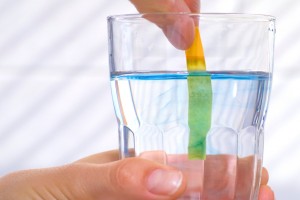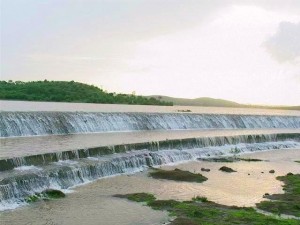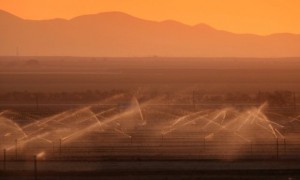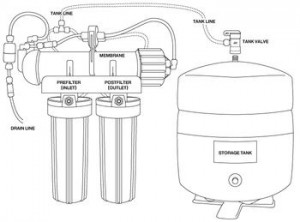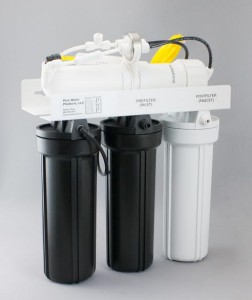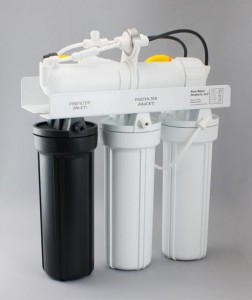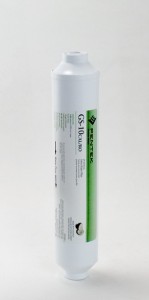The Pure Water Occasional for May 31, 2016
In this late-May Occasional, you'll read about orthophosphate, rain barrels, water birth, fluvial geomorphology, and the dangers of drinking too much water. Plus perchlorate, lead (a lot about lead), nitrates, PFOA, PFOS, and bacteria. Nestle vs. the US Forest Service, the Bendsura Project, National Drug Take Back Day, the mystery of Antarctic ice, the continuing woes of Lake Mead, and the "pH paranoia" being created by marketers. Learn how irrigation may cause rain, how drought affects low-lying islands, how the Black and White RO unit's web presentation is changing, and how guns are being turned into water pumps. Then there's big news about National Garden Hose Day, more news from Flint, good news about a Chinese solar distiller, and, as always, there is much, much more.
The Pure Water Occasional is a project of Pure Water Products and the Pure Water Gazette.
To read this issue on the Pure Water Gazette's website, please go here. (Recommended! When you read online you get the added advantage of the Gazette's sidebar feed to current water stories.)
You'll sing better.
PH Paranoia: Understanding Alkaline Water Claims
The unique properties of mineral free, ultra-pure drinking water actually makes pH measurement meaningless in the body.
by Jack Barber
It’s an all-too-common misconception that alkaline water is the key to perfect health even though claims about the health benefits, or safety, of this water are not supported by much credible evidence. Clever marketers rely on personal testimonials and pseudo-scientific studies to promote alkaline water as a powerful antioxidant that can prevent or reverse many degenerative diseases, including cancer and arthritis, boost energy levels and metabolism and slow the aging process. There is absolutely no scientific proof that any of these claims are true.
In the war of the waters, alkaline water zealots not only shamelessly promote the benefits of alkaline water but take shots at both distillation (D) and reverse osmosis (RO). They believe that drinking DRO water is actually harmful because it can be slightly acidic. The truth is the unique properties of mineral free, ultra-pure drinking waters actually make the pH measurement meaningless in the body. It is important to note that de-ionized, rain and many spring waters also have the same properties that make them acidic.
Explanation of pH and why it matters
To better understand how the body renders this debate meaningless, it is necessary to have a basic explanation of pH. The pH level is a quantitative measure of the hydrogen ions representing the acidity or alkalinity of a solution. The acidic solution has more free hydrogen ions and the alkaline solution has fewer free hydrogen ions. Any substance that lowers pH is an acid and any substance that raises it is a base. Buffers are substances that enable water to resist pH change when an acid or base is added.
The pH scale ranges from 0 to 14 with a pH of 7 being neutral. A pH less than 7 is acidic and a pH greater than 7 is alkaline. The pH scale is logarithmic so for every one unit of change in pH there is a tenfold change in ion concentration. This means a solution with a pH of 3 is 10 times more acidic than a solution with a pH of 4 and 100 times more acidic than one with a pH of 5.
The effects on the pH scale from drinking DRO water
Highly purified DRO water is neutral with a pH of 7. Since there are virtually no dissolved solids (TDS) in this water, there is nothing to influence the pH change in either the alkaline or acid direction or to act as buffers to resist change. That degree of purity makes DRO water extremely sensitive so adding the slightest amount of acid or base will easily change the pH. Even a small amount of carbon dioxide from the air will combine with DRO water to lower the pH to about 6. For the same reason, just a speck of an alkalizing substance like baking soda will immediately raise the pH of a glass to over 7. In contrast, it would require considerably more acid or base to change the pH of mineral water. The difference is the presence of buffers or dissolved solids making it resistant to change. In other words, the pH of DRO water is like a pendulum that can be moved easily with a feather compared to high mineral water that requires a mallet.
Therefore, when you drink slightly acidic DRO water, it immediately combines with the slightly acidic digestive enzymes in saliva and seconds later with very acidic digestive enzymes and gastric juices in the stomach without affecting your pH in any way. In short, the extremely sensitive DRO water pH immediately adjusts to your body rather than your body adjusting to the DRO water pH. The much stronger hydrochloric acid in the stomach with a pH of 1 is about 100,000 times more acidic than any slightly acidic DRO water with which it combines. That renders the pH of DRO water completely irrelevant.
Reasons not to drink alkaline water
According to Dr. Bob Arnot, M.D., who is a well-known author and nutritionist, in a recent Men’s Health Journalarticle, “Say no to alkaline water, it’s a scam. Your body is designed to adjust to its optimal pH balance no matter what you ingest. For instance, once alkaline water enters your stomach, your body simply pours in greater amounts of acid to neutralize it.”
Since the stomach is designed to be acidic, it must produce more acid every time you drink alkaline water to compensate for the dilution of gastric juices. In a previously healthy gut, the constant ingestion of alkalized water can create an abnormal digestive condition. Even drinking alkalized water along with meals can dilute the natural acidity of the digestive tract and interfere with digestion.
Maintaining normal stomach acidity is also necessary to protect against bacterial and viral infections. The acidic environment destroys pathogenic organisms that may be ingested in both food and water. Altering this acid environment leaves you wide open to intestinal infections. At least half of everyone over 60 suffers from some level of low stomach acid. This condition can be compounded by the consumption of alkaline water.
As a Harvard Medical School graduate, nationally known author and nutritionist Dr. Andrew Weil is eminently qualified to evaluate the health claims of alkaline water. He said, “The health claims for water ionizers and alkaline water are bogus. Save your money. You should consider the fact that alkaline water is common throughout the western states, but to my knowledge, it has not protected anyone from the diseases and disorders that occur elsewhere in the U.S.”
Nutritionist and pure water advocate Dr. A. True Ott noted, “Water that is rich in hydrogen measures 5 or 6 on the pH scale (acidic), while alkaline water is actually dehydrating. In my experimentation and research, there is a direct correlation with water purity levels and hydrogen content. Thus, one should strive to consume the purest water possible, water rich in free hydrogen ions. Why then are people often tricked into thinking that drinking water with high TDS contaminants such as ionized water is actually a wise and healthy thing to do? Science and logic scream otherwise.”
Don’t fall for the easy way out
In spite of all the warnings, most people want the best health without the sacrifices needed to achieve it safely. We all love the idea of a quick fix. What better way to correct years of poor nutrition, zero exercise and chronic dehydration than by simply drinking alkaline water? Savvy marketers prey on these consumers, selling useless products that may cause severe long-term side effects. Using nothing more than sales fiction, they have beguiled trusting consumers and created a thriving market for expensive alkalizing gizmos known as ionizers.
These popular ionizers, according to scientists, are not only medically baseless and worthless, but also possibly dangerous. Four Japanese studies have been published in peer journals and independently verified showing that alkaline water caused pathological changes in heart cell muscles and increased the risk of heart attack in laboratory animals.
Normal cells die under extremely alkaline conditions. A study published in the Journal of Biological Chemistry found that alkalosis (rising cellular pH) causes alkaline-induced cell death as a result of altering mitochondrial function. These results raise very serious doubts about the safety of alkaline water.
Dr. David Brownstein, author, international lecturer and foremost practitioner of holistic medicine, said, “I disagree with the claims made about alkaline water. The claims about the benefits of drinking alkaline are made with no supporting evidence. The best way to optimize your pH is to eat a healthy diet full of minerals and vitamins. Eating refined foods like white flour, sugar and salt promote acidity.”
The wide range of pH values needed throughout the body is exquisitely balanced, primarily through a complex system of buffering and breathing. There are, however, some simple things you can do to maintain a naturally healthy pH. Eating more fruits and vegetables, practicing deep breathing and drinking plenty of pure hydrating water will enable your body to more easily remove toxins and acid metabolic wastes.
Other factors, such as lack of exercise, emotional stress, medication, coffee, alcohol and smoking, can adversely affect the internal pH of your body over an extended period of time. Thus, improved health is not a quick-fix but a slow, cumulative process consisting of numerous lifestyle choices.
It is my sincere hope that this combination of scientific studies, expert advice and common horse sense settles the pH debate so we can all freely enjoy the pure, oxygen-rich elixir of life without any pH paranoia.
Source: Water Technology.
Pure Water Gazette Fair Use Statement
EPA Requests Flint Residents to Help Flush Lead from Water Lines
The U.S. Environmental Protection Agency (EPA), in coordination with the State of Michigan Department of Environmental Quality and the city of Flint, said that people in Flint should run the water in their homes and businesses to aid in the recovery of the city’s drinking water system.
The recommended flushing program aims to remove loose particles of lead from service lines and from the pipes in homes and help distribute orthophosphate, the corrosion control chemical that builds a protective coating in pipes and protects against lead exposure.
Beginning May 1, the following steps are recommended for residents to flush the system:
- Run cold water at the highest flow in the bathtub for five minutes. Do not use the showerhead because it has a lower flow rate.
- Bypass or remove your filter, then run cold water at the highest flow from the kitchen faucet for five minutes. Remember to turn your filter back on or reinstall it when done. EPA testing has shown filters are effective at removing even very high levels of lead.
- Do this every day for 14 days.
The EPA explained that there will be no additional cost to residents related to this flushing program. Residents will be compensated for the cost associated with flushing in addition to receiving water credits already awarded by the state.
Current advice to Flint residents states they should only consume filtered or bottled water because of high lead levels in the water system.
Are you drinking too much water?
Editor's Note: We're usually warned about drinking too little water. This piece, adapted from an earlier Occasional, warns of drinking too much. We've added a clip from a recent article by Dr. Mercola. The principle of the Golden Mean, "nothing in excess," applies to water as well as vodka. --Hardly Waite.
The reason why over hydrating can be dangerous is that when we consume large amounts of water when exercising, blood plasma (the liquid part of blood) increases, while the sodium concentration in the body fluids decreases, both as a result of the dilution by the water but also because sodium is lost by sweating.
Hyponatremia, or low blood sodium, generally happens after drinking too much plain water and can lead to adverse effects and tissue damage, and interfere with brain, heart, and muscle function.
Early symptoms can be difficult to spot and include:
- Confusion
- Nausea
- Fatigue
- Muscle cramps
- Weakness
More severe symptoms can include vomiting, muscle twitching, delirium, seizures, coma and death.
A review of three deaths of US military recruits highlights the dangers of drinking too much water. Like in sports, the military has traditionally focused on dangers of not drinking enough, especially under conditions often associated with exercise and hot conditions. However, getting overzealous over the need to drink large amounts of water and over-hydrating can have deadly consequences.
The following is from a recent article by Dr. Mercola:
You might think that you couldn’t ever drink too much water, but you would be wrong. Over-hydration is an excess of water in the body, which can create an imbalance in your electrolytes. Normally your kidneys can excrete water fairly quickly.
However, when you drink a lot of water in a short period of time, you may experience some of the symptoms of too much, too soon. If you have kidney disease, you may not be able to excrete excess water as efficiently and can suffer from over-hydration.
The imbalance in sodium and potassium can result in confusion, loss of consciousness or seizures. In the early stages you may appear to be drunk from the lack of electrolyte balance in your brain.
Although rare, the drop in sodium levels, called hyponatremia, is called water intoxication. The problem occurs when you drink a surplus of fluid without giving your kidneys time to excrete the excess.
Your kidneys can filter and excrete approximately one-half liter (approximately 16 ounces) each hour. When you out drink your kidneys, you can get into trouble. For the entire article, see "Are you peeing too much?
 Perchlorate is used in rocket fuel. fireworks, and explosives. You are more likely to have perchlorate in your water if you live near a military base.
Perchlorate is used in rocket fuel. fireworks, and explosives. You are more likely to have perchlorate in your water if you live near a military base.
Perchlorate in drinking water
Perchlorate occurs naturally in some soils but gets into our water mainly because of its use as an ingredient of explosives and rocket fuel. Military installations are frequently contaminated. In 2011, the Obama adminsitration reversed a Bush ruling that perchlorate is of no consequence to health and instructed the EPA to go about regulating levels in water. The EPA has not set a national allowable standard for perchlorate in water, but two states, California and Massachusetts, have adopted their own enforceable standards. The effects on human health of exposure to perchlorate are not fully understood, but large amounts of perchlorate are known to affect thyroid function, growth, and metabolism.
Perchlorate is best removed from drinking water by reverse osmosis, but it is also reduced by carbon filtration, anion exchange, and distillation.
For more information, see the perchlorate page in our information archive and the EPA's status report on perchlorate.
Lead is Everywhere
As current news stories indicate, elevated levels of lead are being found in homes, in schools, and in public buildings throughout the US and Canada. This may mean that lead contamination is becoming more prevalent, but it may also mean that because of the national focus on the Flint, MI lead problem more homeowners and especially more public officials are testing for lead.
Whatever the cause, lead can be fairly easy to deal with in the home with an undersink reverse osmosis unit or with an undersink or countertop filter with lead-removal capability.
National Drug Take Back Days
In 2010, the US Drug Enforcement Agency (DEA) began hosting National Drug Take Back Days to encourage people to turn in their unused prescription drugs for safe disposal, rather than flushing them down the toilet. On the latest Drug Take Back Day last month, approximately 447 tons of drugs were collected at 5,400 collection sites across the U.S., beating the agency's previous record of 390 tons collected last fall.
Prescription drugs are included under the umbrella of emerging contaminants. Improper disposal - whether they are flushed down the toilet, rinsed down the sink or thrown in the trash - can result in the drugs reaching water supplies, not only affecting aquatic animal and plant life, but also entering water supplies and potentially affecting human health. Levels of hormones and other prescription medications have been found in varying levels in water sources across the country, and water and wastewater treatment plants often are not equipped to handle them.
The New Date for National Garden Hose Day Is June 22
Be advised that National Garden Hose Day, which has been celebrated on August 3 since its inception, has been moved to June 22. Although event officals did not give a reason for the change, many suspect that it was occasioned by a marked decline in interest for the holiday last year. In fact, one of the event's coordinators, who wishes to remain anonymous, said that there has always been some concern about the late-summer date. "By August," he said, "people are tired of their lawns, tired of their gardens, and tired of garden hoses. It just makes sense to move the date up a bit."
Watch the Gazette for complete Garden Hose Day coverage in weeks to come.
More about National Garden Hose Day.
Gazette's Famous Water Pictures Series: The Bendsura Project
The picture above shows the severity of drought in the Indian state of Maharashtra.
After several years of drought the reservoir that once supplied water to the entire nearby city of Beed is now empty. Half of this western state — 28,000 villages — is battling a severe water shortage.
The reservoir project dates to 1955 when the reservoir was constructed on the small Bindusara (a.k.a. Bendsura) River.
Below is what the Bendsura Project looked like at one time:
Water News for May
Nestle vs US Forest Service
Nestle is objecting to the U.S. Forest Service’s terms for issuing it a new permit to continue piping water out of a national forest, saying the agency is overstepping its authority and infringing on the company’s water rights.
Nestle piped 36 million gallons of water from the national forest last year to produce bottled water. That has sparked an emotional debate during the drought, with opponents arguing that taking water harms the environment and wildlife along Strawberry Creek – and that the impacts on the ecosystem need to be scientifically assessed. Details from USA Today.
Solar Still in China
Researchers in China have developed a much improved solar water distiller enhanced with aluminum that significantly speeds up the desalination process. The new technique could make desalination affordable even for individual households. On a large scale, it is much more cost effective than current RO desalination technology, which relies on fossil fuels. Details from Science.
Bacteria in Wisconsin's drinking water has been called a public health crisis.
Between 2007 and 2010, an estimated 18 percent of 3,868 private wells in Wisconsin tested positive for coliform bacteria — an indicator of disease-causing bacteria, viruses or parasites — according to a 2013 study by researchers with the state Department of Health Services. That translates into as many as 169,200 of the 940,000 Wisconsin households served by private wells exposed to disease-causing pathogens.
The problem also plagues municipal water systems where coliform bacteria accounts for most of the violations of health standards recorded each year. The 2014 Department of Natural Resources drinking water report on the state’s public water systems found 3.7 percent, or 420 of the 11,420 systems, had detectable levels of coliform.
The report said those 420 systems serve about 92,290 people. Most of the violations, 351, were in small public water systems serving motels, restaurants, churches and campgrounds.
Contamination by pathogens is of special concern because unlike pollution by metals or chemicals, pathogens can sicken people after just a single exposure. The gastrointestinal illnesses that result can be life-threatening for people with weakened immune systems such as the sick, elderly and infants.
Pathogens such as bacteria, viruses and parasites are the most frequent causes of illnesses in private water systems, according to the U.S. Centers for Disease Control and Prevention. Comprehensive article at Madison.com.
The easy fix for bacteria in home water supplies is ultraviolet treatment.
In Detroit, some 30,000 individuals and businesses have arranged payment plans with the city to keep their water turned on. Of these, 23,000 are in default and in danger of losing their service. Details.
How much do you know about rain? Take Mother Nature Network's quiz.
What makes a river bend? Because of the wonders of internet technology, you can take a free course in fluvial geomorphology and its relationship with watersheds, including the common terms and watershed elements, stability and in-stability definitions and conditions, and causes of river instability. Also included are watershed hydrological classification, channel profile and shape, and limitation of channel layouts for stream restoration projects. Go here.
Water splashing on to ploughed fields throws up microscopic particles – dust that often helps to seed clouds and generate rainstorms
New findings suggest that the act of water splashing onto ploughed fields throws up millions of microscopic particles – the remains of dead plants and animals. And it turns out that this special dust often helps to seed clouds and generate localised rainstorms. Read the full story about making rain with water in the Guardian.
Drought Is a Major Concern on Low-Lying Islands
Wells have become brackish or run dry; the rain barrels that perch on the corners of houses have little or no rainwater left in them. Water rationing is limited to a couple of hours a day in some of the worst-hit communities, while expensive reverse-osmosis machines have been shipped out to the most far-flung atolls to make the seawater drinkable. Staple foods like breadfruit and bananas have shriveled on the trees, inedible. Details.
The Dallas Morning News reported that three of Texas' thirteen state-run centers for the disabled have reported unsafe levels of lead in their drinking water. Details. And in Canada high levels of lead were found in the drinking water of 19 Delta schools. More.
There was a large cash settlement in a lawsuit involving a botched water birth.
EPA Cracks Down on PFOA and PFOS
Federal officials released stricter guidelines for human exposure to this industrial chemical, which has been touching water for decades due to its prevalence in consumer products.
Perfluorooctanoic acid, more popularly known as PFOA, has been detected in the tap water of many towns near industrial sites where it is manufactured.
A related concern is perfluorooctane sulfonate (PFOS), which is used in firefighting foam.
Tighter guidelines issued by the Environmental Protection Agency (EPA) for these chemicals came after years of mounting pressure from public groups and health experts. The new set limits were driven by recent scientific findings linking PFOA and PFOS to conditions such as testicular and kidney cancers and birth defects. Details.
Lake Mead has declined to the lowest level in history. Details.
High levels of nitrates, atrazine and arsenic in drinking water are linked in a new U.S. study to birth defects such as cleft palate, cleft lip and limb deficiencies. Details.
This video shows Texans how to build their own rain barrel. (It may work in other states as well.)
The Glen Canyon Dam and Others May Be Facing Extinction
Many of the West’s big dams have proved far less efficient and effective than their champions had hoped. They have altered ecosystems and disrupted fisheries. They have left taxpayers saddled with debt. Details from the New York Times.
A mystery: While the Arctic's sea ice is shrinking, why is the Antarctic's growing? Cosmos Magazine.
A Presyterian group in Malawe is literally turning guns into water pumps. Details.
Simple Reverse Osmosis Units with Lots of Options
After many years of selling our famous (to us, at least) Black and White reverse osmosis units, we've decided to change the way we present them. The core product will be the same tough, simple unit, but our website presentation will soon allow customers to build their own RO unit by choosing from among three basic designs then adding features. The simple three-stage unit, the core product, which has been by far the most popular style over the years, will actually go down in price, but some of the add-on options that we've been giving away to phone customers will be added for selection on the website at a modest increase in price.
We're now going to build the basic units in 3 formats only. You can see them in the pictures below.
By far the most popular style is the simple three-stage unit consisting of a carbon block prefilter, the RO membrane, and a carbon block postfilter.
Three Stage Black and White RO Unit
This most basic undersink RO unit, the "three stage," has a prefilter (vertical canister on the left in the picture), an RO membrane (the horizontal canister), and a postfilter (right vertical canister). "Pre" means that the filter comes before the membrane, and "post" means that it comes after. The prefilter is normally a carbon block filter, since it has to protect the membrane from chlorine or chloramine in city water. (On unchlorinated well water, a simple sediment filter may be used.)
The basic three stage unit shown above has all the essentials that make undersink RO units such excellent performers: two top quality carbon filters to remove disinfectants and chemical contaminants and an RO membrane to deal with the hard-to-remove contaminants that carbon doesn't handle, like lead, arsenic, nitrates, and fluoride. The membrane also reduces the dissolved solids (called TDS, for total dissolved solids) by about 95%. (All Black and White units come with a hand-held TDS tester so that membrane performance can be verified.)
Most standard "4-stage" RO units on the market use two full-sized filters plus a small refrigerator filter clipped to the membrane as the final carbon stage. Black and White 4-stage units, by contrast, use three full-sized filters plus the membrane. In all Black and White units, prefilters are housed in black vessels and postfilters are in white housings. The unit pictured below has two prefilters (black) and a single postfilter (white).
Black and White 4-Stage with Two Pre-Filters
Having two prefilters allows a variety of cartridge choices. Here are some prefilter cartridges that might be added as the first or second prefilter element:
- A sediment filter.
- An additional carbon block filter.
- A scale prevention cartridges to protect the membrane from scaling.
- A KDF55 stage to enhance chlorine removal and inhibit growth of bacteria within the unit.
- An iron filter to protect the membrane from iron or manganese.
- An oxidizing prefilter to enhance arsenic reduction.
- A KDF85 stage for pretreatment of smelly well water.
Black and White 4 Stage with Two Post-Filters
With two postfilters, here are some popular choices for the extra postfilter stage:
- An extra carbon block filter.
- A ceramic or other extremely tight filter to assure bacteria-free water.
- A pH/alkalinity increaser.
- A cation (softener resin) cartridge to remove ammonia.
- A deionizing (DI) cartridge to remove ammonia and reduce all dissolved solids to zero.
All Black and White units built in the three basic styles above come with cartridges of your choice. The price of the unit is the same regardless of the cartridges selected.
Add-ons and Upgrades
This Calcite/Coconut shell inline filter that gives a mild increase to pH and TDS is a popular postfilter add-on.
Black and White units are now built only in the three basic formats shown. Any additional components are viewed as add-ons, not additional "stages" to the RO unit. Popular add-ons are inline sediment or carbon filters, ceramic filters, calcite filters, and scale reducers. Add-ons of this type usually come with their own mounting bracket for placement near the main unit.
The standard faucet for Black and White units is the top quality conventional chrome Tomplinson ProFlo. It comes as standard equipment with the RO unit. There is an extra charge for upgrading to Tomlinson Designer and Contemporary faucets that are offered in a variety of finishes as options. Other Tomlinson models are available by special order.
Performance upgrades are offered at a modest upcharge. These are all features that require a special rebuild of the basic units. They include:
- Adding a performance boosting permeate pump to the unit.
- Substituting a water saving Pentek encapsulated membrane for the standard Filmtec membrane.
- Furnishing the unit with 3/8" tubing from the storage tank to the faucet to enhance flow to faucet and refrigerators.
- Including a kit to connect the RO unit to a refrigerator or other remote point of use.
Added equipment, of course, can be included for the price of the equipment itself:
- Adding an extra storage tank or a larger capacity storage tank.
- Adding a "demand pump" setup to deliver RO water to a remote location.
- Adding a "booster pump" to increase pressure coming into the RO unit.
- Adding a a small ultraviolet unit either before or after the RO unit.
Watch for these changes on our Black and White reverse osmosis page, coming soon.
Please visit our RO Parts Page for tanks and accessories. We also have dedicated parts pages for countertop water filters, undersink filters, and aeration equipment. We stock parts for everything we sell.
Thank you for reading. Please come back next week.
Places to Visit on Our Websites:
Garden Hose Filters. Don’t be the last on your block to own one. And don't forget that National Garden Hose Day is just around the corner.
Model 77: “The World’s Greatest $77 Water Filter”
”Sprite Shower Filters: You’ll Sing Better!”
An Alphabetical Index to Water Treatment Products
Our famous whole house Chloramine Catcher
Single Tank Aerators for Iron and Hydrogen Sulfide
Pure Water Occasional Archive: Sept. 2009-April 2013.
Pure Water Occasional Archive: April 2013 to present.
Write to the Gazette or the Occasional: pwp@purewaterproducts.com
Please Visit
The Pure Water Gazette – now with an up-to-the-minute feed of the latest water news.
![occasionalbanner300[1]](https://ymlp.com/https.php?id=purewatergazette.net/blog/wp-content/uploads/2013/04/occasionalbanner3001.gif)


